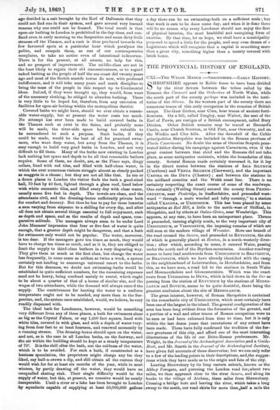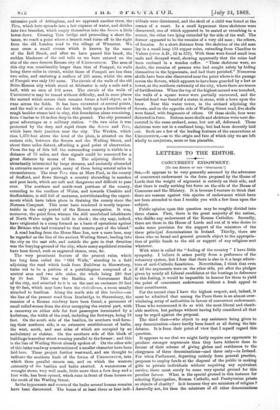THE PROVINCIAL HISTORY OF ENGLAND.
cx.r.—THE WELSH MARCH :—SHROPSHIRE.--EARLY HISTORY.
SIIROPSHIRE appears in Keltie times to have been divided by the river Severn between the tribes called by the Romans the Carnavil and the Ordo vices of North Wales, while the south part of the county perhaps was included in the terri- tories of the Silures. In the western part of the county there are numerous traces of this early occupation in the remains of British camps. The (her ditches, near Clan, bear traces of ancient forti- fications. On a hill, called Tongley, near Walcot, the seat of the Earl of Fowls, are vestiges of a British encampment, called Bury Ditches. Other British remains may be traced at Brocarclis Castle, near Church Stretton, at Old Port, near Oswestry, and on the Wrekin and Clee hills. After the downfall of the Celtic principalities Shropshire was included in the Roman province of Flavia Cmsariensis. No doubt the arms of Ostorius Scapula pene- trated hither during his campaign against Caractacus, even if the great contest between that chief and the Romans did not take place, as some antiquaries maintain, within the boundaries of this county. Several Roman roads certainly traversed it, for it lay in the direct routes between the stations of boa &Luxus& (Caerleon) and VENTA SILUEIIII (Caerwent), and the important CASTRA on the Dime (Chester) ; and between the stations in the midland counties and the Welsh coast line. There is no certainty respecting the exact course of some of the roadways. One certainly (Watling Street) entered the county from PERKO- CRUCIIIII, near Penkridge, in Staffordshire, and proceeded west- ward "through a more wooded and lofty country," to a station called UXACONA, or UXICONIIIIL. This has been placed by some antiquaries at Red Hill, a little to the north-west of Shiffnal, in Shropshire, and by others at Oaken-Gates, near Wembridge. This appears, at any rate, to have been an unimportant place. Thence it proceeded, taming slightly south, to the very important city of Uniocomust, or Vistocomust, the imposing remains of which are still seen at the modern village of Wroseter. Here one branch of the road crossed the Severn, and proceeded to Ruirrasium, the site of which is generally placed at R,owton, in a north-westerly direc- tion; after which, according to some, it entered Wales, passing under the north end of the Brython mountains. Another roadway seems to have lead southwards from UMOCONIUM IO BRAVINTErM, or BEAVONIUM, which we have already identified with the camp in the neighbourhood of Leintwardine, in Herefordshire, and from this, as we have seen, a road led to the stations in South Wales and Monmouthshire and Gloucestershire. Which was the exact route from Urioconium to DEVA, which is laid down in the Iter as passing from the station of RIITUNIUM by the stations of MEnio- LA.NUM and Bovium, seems to be quite doubtful, there being the greatest confusion about the site of MEDIOLANIIII.
The great interest, however, of Roman Shropshire is contained in the remarkable city of URIOCONIUM, which must certainly have been one of the largest in the island. The general,configuration of the area has been long evident from the formation of the ground, and a portion of a wall and other traces of Roman occupation were to be seen or had been exhumed from time to time, but it is only within the last dozen years that excavations of any extent have been made. These have fully confirmed the tradition of the for- mer greatness of this city, and afford one of the most interesting illustrations of the life of our Brito-Roman predecessors. Mr. Wright, in the Journal of the Archmological Association and a Guide. Book, and Mr. Scarth in the Journal of the Archmological Institute, have given full accounts of these discoveries; but we can only refer to a few of the leading points in their descriptions, and,the sugges- tions which they have made as to the origin and fate of the city.
Leaving Shrewsbury by its long eastern suburb, known as the Abbey Foregate, and pursuing the London road for about two miles, we then approach close to the river Severn, and along its banks to the village of Atcham, three miles from Shrewsbury. Crossing a bridge here and leaving the river, which takes a long sweep to the south, our road skirts for more than,,half a mile the extensive park of Attingham, and we approach another river, the Tern, which here spreads into a fair expanse of water, and divides into two branches, which empty themselves into the Severn a little lower down. Crossing Tern bridge and proceeding a short dis- tance, we reach a point where a branch road turns off to the right from the old London road to the village of Wroxeter. We soon cross a small stream which is known by the name of the Bell Brook, and after we have passed this brook, the sudden blackness of the soil tells us we have entered on the site of the once famous Roman city of Cfmocomum. The area of this city was considerably larger than that of Pompeii, its walls being three miles in circuit, whilst those of Pompeii are less than two miles, and enclosing a surface of 223 acres, whilst the area of Pompeii was only 160 acres. The circuit of the walls of the old Biito-Roman city which stood at Silchester is only a mile and a half, with an area of 102 acres. The circuit of the walls of Untocomum may be traced without difficulty, and in some places the mound which covers their remains forms a bold object, as it runs across the fields. It has been excavated at several points, and the wall is of stone six feet wide, built upon a foundation of rough boulder stones laid in clay, this foundation alone remaining, from 6 inches to 18 inches deep in the ground. The city possessed great advantages as a military station. "On two sides it was protected by the deep and rapid rivers the Severn and Tern, which have their junction near the city. The Wrekin, which rises 1,370 feet above the level of the plain, is situated on the eastern side, between the Severn and the Watling Street, and about three miles distant, affording a good point of observation. From the top of this hill the surrounding country is visible to a distance of 75 miles, and thus signals could be conveyed for a great distance by means of fire. The adjoining district is abundantly intersected by large streams, and anciently abounded in extensive meres or pools, many of them being several miles in circumference. The river Tern rises at Mere Pool, in the county of Stafford, and flows through a country abounding in marshes and peat lands, which are soft and dangerous and difficult to pass over. The northern and north-west portions of the county, extending to the confines of Wales, and towards Cheshire and Staffordshire, is still full of morasses, notwithstanding the experi- mente which have taken place in draining the county since the Norman Conquest. This must have rendered it nearly impene- trable in the early period of the Roman occupation. It was, moreover, the point from whence the still unsubdued inhabitants of North Wales might be held in check ; the city may, indeed, have originated in a camp formed as a basis of operations against the Britons who had retreated to that remote part of the island."
A road leading from the Horse Shoe Inn, now a mere lane, may be regarded as the line of the ancient Watling Street, leading into the city on the east side, and outside the gate in that direction was the burying-ground of the city, where many sepulchral remains have been found, such as engraved stones, urns, &c.
The very prominent feature of the present ruins, which has long been called the "Old Walls," standing in a field adjoining the road which leads from Buildwas to Shrewsbury, turns out to be a portion of a parallelogram composed of a central area and two side aisles, the whole being 220 feet by 60 feet. This was the Basilica or Government Hall of the city, and attached to it is on the east an enclosure 26 feet by 60 feet, which may have been the chalcidicum, a room usually attached to basilicas. Along the north side of this basilica—on the line of the present road front Ironbridge to Shrewsbury, the remains of a Roman roadway have been found, a pavement of small rolled stones from the river occupying the central part, with a causeway on either side for foot passengers terminated by a kerbstone, the width of the road, including the footways, being 18 feet. On the south side of the basilica, its southern wall form- ing their northern side, is an extensive establishment of baths, the west, south, and east sides of which are occupied by an ambulatory or cloister. On the southern side of this block of buildings is another street running parallel to the former ; and this is the line of Watling Street already spoken of. On the other side of this latter roadway constructions of a smaller character have been laid bare. These project further westward, and are thought to indicate the southern limit of the forum of URIOCONIUM, into which these parallel streets ran, and on which the western extremity of the basilica and baths abutted. A watercourse of wrought stone, very well made, little more than a foot deep and a foot wide, has been opened, which runs in front of these houses on the south of the Watling Street.
• Lithe hypocausts and courts of the baths several human remains have been discovered. The bones of at least three or four indi-
viduals were disinterred, and the skull of a child was found at the corner of a court. In a small hypocaust three skeletons were discovered, one of which appeared to be seated or crouching in a corner, the other two lying extended by the side of the wall. The former appeared to be the remains of a very old man ; the others, of females. At a short distance from the skeleton of the old man lay in a small heap 132 copper coins, extending from Claudius to Valens (circa A.D., 52 to 379). With these were found small iron nails and decayed wood, showing apparently that the coins had been enclosed in a wooden coffer. "These skeletons were, no doubt, the remains of persons who had sought safety by hiding themselves in the hypocausts, and had there perished." Numerous skulls have been also discovered near the point where is the passage across the Severn, which appears to have been guarded by a fort or tower, at the southern extremity of the city, where there are traces of fortifications. When the top of the highest mound was trenched, the walls of a square tower were partially uncovered, and the bearded head was found of a statue in stone, with a horn upon the brow. Near this water tower, in the orchard adjoining the Severn, and on the opposite side of Watling Street road, five skulls were found, with fragments of others. Of these skulls, four were distorted in form. Sixteen more skulls and skeletons were next dis- covered in the same orchard, some, but not all,- deformed. These skeletons were not in a confused heap, but had been decently laid out. Such are a few of the leading features of the excavations at Uniocomuti,—as to the origin and fate of which city we are left wholly to conjecture, more or less plausible.































 Previous page
Previous page